Aah...Greece. The Parthenon, Gyros and good-looking men - particularly the young ones. I've been told they're a bit Macho, but I've not met many men who don't have a touch of Macho in 'em. Lots of women, too, I include myself. Besides, doesn't cost to look.
I can't get my math straight, but my total flying time was about 19 hours and the time difference is 10 hours. I flew from Portland to Chicago to Zurich to Athens, thank God I didn't have to race through any of the airports with my wheelless carry-on. Because of my midnight return flight, I opted to rent bookend rooms near the airport with on-site parking and 24 hour shuttle service, definitely worth it for the peace of mind. (Photo: First glimpse of Athens; look how beautiful the water.)
During the longest leg (Chicago to Zurich, 10 hours), my area was empty, as you see. I couldn't believe my luck; imagining a quiet, roomy ride, maybe even extra food. Woulda been perfect if not for the colicky baby in the section behind me, whose mother walked up and down the aisles to be certain we all shared her misery, thought I'd lose my mind. The Steward assured me that, compared to other flights, it wasn't so bad. I have the same impression about graffiti; everyone's tolerance level differs.
At the Athens airport, I missed by an hour the shuttle to the hotel with the Reno crowd...WAIT, I never explained how I managed to be on this trip, and with who:
In a nutshell, my good friends from Nevada (seated, front row right) founded the non-profit Toccata Symphony Orchestra & Chorus almost 20 years ago. They've organized European tours every couple years for interested members, patrons and guests, where they sight-see and perform along the way.
This year's trip was Athens and a cruise through the Aegean, and Nancy asked if I'd like to go along. People were flying in from all over and meeting up at the hotel. The picture above was taken on the rooftop of the Stanley Hotel, I added the red arrow. I didn't really know anyone other than James and Nancy, but casually met some of the musicians over the years when I helped at Toccata's concerts.
Despite studying, "Learn to Read Greek in 5 Days," I couldn't understand a thing as I zipped through the airport. I caught a taxi with Nico, a nice guy who tried to teach me some Greek as he skilfully navigated the half-hour drive through rush-hour Athens. The windows were open and it was warm but not stifling at 4 pm. I stared out the windows at 3-and-4-story apartments and shops, all with balconies and most with awnings. The sun was bright, the sky clear and the temperature comfortable. "It's nice out today," I observed.
"It's ALWAYS like this," Nico laughed. Turns out we experienced warmer than average temperatures throughout the trip: in the low-to-high 70's, interrupted only once by a brief deluge. Good thing I decided not to pack my travel umbrella, for I overpacked as it was; but I wasn't the only one to claim, "I brought the wrong clothes - it was supposed to be colder!" (Photo: Interesting architecture tucked among modern construction.)
Yes, it is. An amazing site above the sprawl of Athens; you just stand in the street and stare. A Welcome Buffet for the group had already begun, and despite 20+ hours traveling with little sleep, I was pumped and ready to go.
I sprang for a Single hotel room (two double-beds), and was glad I did, the privacy and space were worth every penny. I quickly unpacked enough to grab something for the Welcome-Party; and after realizing the microwave was actually a safe, I locked away my passport and valuables and headed upstairs to meet 80 strangers.
While sipping my first Mocktail on the rooftop balcony I tried to remember mythological stories we were taught in school, I loved those. Aunt Cathy, who was Greek, would have been tickled. I wanted to pinch myself: after all the planning, saving and anticipating, I was actually in Greece.
The rooftop pool area looked like photos you see in ads, but there wouldn't be time to stick my toes in, even if I could manage to squeeze into a suit. But it's a perfect spot for sipping something yummy in a lounge chair.
 |
| Karaiskaki Square, Athens |
Organized vacations aren't really my cup-of-tea, but the chances of me deciding to up and head for such an extensive trip like this were nill, since I'm more of a fly, rent-a-car and take my chances gal. To take full advantage, I signed up for an excursion every day of the trip.
Only problem: I was out of shape. It was hard just walking around the RV park without huffing and puffing...how could I possibly climb to the top of the Acropolis? For months I tried maintaining an exercise routine, either walking around the park or treadmilling in the gym; until the week before I left I threw up my hands and figured I'll either make it or I won't. If I'm too tired or achy I could skip a trip and stay on the ship; but I hoped my travel walking stick for short people would save me.
In the lobby the next morning was a notice board papered with lists of names and bus assignments: Musicians; Friends and Others; and those needing Extra Assistance. I asked about Acropolis elevators (unreliable) and hoped to be on the third bus, but was assigned F&O. It was suggested we bring our own snacks and beverages, so I stepped outside the hotel and walked around the block. stopping at a shop loaded with yummy-looking breads, pastries and pre-made sandmiches; then grabbed a bottle of water at a sidewalk kiosk, all without understanding Greek, thank God we have fingers. So inexpensive. I returned in enough time to head up to the roof for more pictures with new friends, then, excitedly, we went to the lobby to wait for the buses.
But just as they began boarding I realized I didn't have my cane. I flew up to my room then the rooftop, but the 9am Bartenders said nothing was turned in. You can imagine inside my head: remembering; praying; kicking myself for not being more careful.
Back down to the lobby, where my friends managed to drum up a substitute from Reception, but I wanted to try the roof once more and sure enough, there it was draped over the same chair just prior to shooting this picture. I was winded but imagine my relief; and off we went, me dabbing at perspiration. Lord, give me strength!
In early April, high season had not yet begun. I've said I haven't travelled overseas in 30 years, when off-season crowds were nowhere near this large. I couldn't imagine the middle of summer - all those people under a hot sun? No, thanks.
A limited number of tourists were permitted to enter at a time; and along the meandering walkway to the top were these costumed Guards, maybe to deter people tempted to grab 'a piece of the rock'.
At least the sky was cloudy and it wasn't overly warm.
Scaaffolding may spoil pictures a bit, but it's vital to fix botched repairs and continue the process. Magnificent, nevertheless. The new marble pieces will eventually age to blend with the original. They're hoping restoration will be finished in 15-20 years; our guide joked 40.
So why was the Parthenon built? In a nutshell, it was built in the 5th centurn BC in thanks for victory over Persian invaders during the Greco-Persian Wars. Dedicated to the goddess Athena, it served as the treasury for the Delian League.
Note: I confess that I knew very little of the places I was about to visit throughout the tour, and more than once remarked to others, I can't wait to read up on what I've seen! Info provided throughout is meant as reference and not necessary 100% accuracy, that's not my forte.
Originally, an enormous statue of Athena stood in the center of the Parthenon. This recreation is housed in Nashville’s Centennial Park. She is the largest indoor sculpture in the western world. Photograph by Dean Dixon,;sculpture by Alan LeQuire.
"The statue seems to have been over 12 meters tall, nearly 41 feet. The parts of her flesh that were visible were made of ivory, and her dress, her armor and her jewelry were made of 40-44 talents of gold. A talent is approx. 57 to 58 pounds, and so the Athena wore on her body a tremendous sum, and was the single greatest financial asset of the city. She disappeared from the historical record after the first centuries of the Common Era and almost certainly no longer exists."
And, sheepishly, from AI: "The Parthenon has suffered significant damage over the centuries, including from earthquakes, fires, wars, explosions, and looting." It's useful for some obvious answers. Still, by accounts the Parthenon was pretty-much in shape, until:
"In 1687 the Parthenon was severely damaged by an explosion of gunpowder that had been stored inside, as the Venetians sieged Athens' Ottoman garrison that had taken refuge on the Acropolis."
(R) Odeon of Herodes Atticus. From Greeka:
"This ancient Theatre was built in the Roman Times, in about 161 AD by the philosopher, teacher and politician Herodes Atticus in memory of his wife Regilla who died in 160 AD. The Theatre used to be covered and had a seating capacity of 5,000 individuals." Performances are held to this day.
I was half-listening while fidgiting with my camera and missed a lot, but it was hard to concentrate. Too much stimuli at one time for my brain.
Plus I was getting used to a new pair of progressive glasses, so as to see things in the distanceas yet still able to read my (Greek, pun intended) camera settings.
Which led to me losing my entire group.
Black shirts with logos were distributed at the buffet the night before, but it seemed most of my group opted for more sun-reflective colors. I began to panic, desperately searching for Judi's huge-brimmed hat; but lots more people were around and I'm short.
(Below) The Erechtheion, or Temple of Athena Polias, featuring the Porch of the Maidens.
"The Erechtheum is inextricably linked to the mythological origins of Athens. Among the most sacred items held in the eastern part of the temple was the (olive wood) cult statue of Athena, which according to some sources had fallen from the sky.
"The Erechthe is dedicated to multiple deities, reflecting the diverse and complex religious beliefs of ancient Greece. Among the sacred sites within the temple is the shrine of Athena Polias, the divine protector of Athens, as well as the mythical tomb of Erechtheus, the city’s legendary founder.
"The Porch of the Caryatids: the sculpted female figures which act as supporting pillars are thought to represent maidens from the Laconic city of Karyes, hence their name. It is believed that the Porch of the Caryatids was made to memorialize the tomb of Cecrops (or Kekrops) – the mythological half-serpent king of Attica. An opening on the western side of the porch allowed access to the tomb.
"The Caryatids currently at the Erechtheion are replicas of the originals that once adorned the temple. One of the statues, along with more than half of the decorative sculptures from the Parthenon that had survived, was removed by Lord Elgin between 1799 and 1802, prior to the Greek War of Independence of 1821. This collection is currently on display at the British Museum." The figures each have individual, stylized features: hair, facial, gown.
"The remaining five were removed from the temple in 1978 for protection, preservation and restoration purposes and are currently on display at the Acropolis Museum. The Greek government has formally demanded the repatriation of the Acropolis sculptures, with the UK government and British Museum refusing. The unresolved dispute is a source of major controversy in Greece."
 Here I was, literally in the footsteps of one of the greatest civilizations ever...but all I could do was concentrate on NOT panicking while navigating uneven ground. Eventually I bumped into the Musicians group, some in their black shirts, posing for an impromptu photograph at the back side of the Parthenon. I'm sure my group hasn't passed them, so I must be ahead of them. They were probably learning about the Temple of Athena, oh well.
Here I was, literally in the footsteps of one of the greatest civilizations ever...but all I could do was concentrate on NOT panicking while navigating uneven ground. Eventually I bumped into the Musicians group, some in their black shirts, posing for an impromptu photograph at the back side of the Parthenon. I'm sure my group hasn't passed them, so I must be ahead of them. They were probably learning about the Temple of Athena, oh well.Group #1's guide, while explaining a significant event, recognized a stranger amongst her flock; but despite my protests that I'd stay put until Friends and Others caught up, she insisted on radioing MY guide, and waited with me until we saw his hand waving in the distance, so embarassing. I felt like I was lost at a mall. At least while waiting I did learn about the Greek Flag on the tower, in a nutshell:
On May 30th, 1941, two teenagers crept through an ancient passageway they discovered from reading Greek text books to tear down the Swastika flag, leaving the flagpole empty in one of the first and most famous acts of resistance against occupying forces.
We ended our tour at the Acropolis Museum, which was too brief (Click on the link for a brief meandering through the museum). Again, we were on a time schedule and the place was pretty busy, so I continued snapping photos because I knew they planned a bathroom stop at the end, and I didn't need to go. I wouldn't lose them again.
Beneath the Acropolis Museum are the ruins of an ancient Athenian neighborhood. Clearly visible are the remains of streets and houses, bathhouses and workshops. The museum was constructed to enable visitors to look onto these ancient foundations from as early as the 5th century BC.
 Our Guide offered plenty of information, which pretty much went in one ear and out the other; so for that reason I blatently grabbed some basic online information to accompany the pictures.
Our Guide offered plenty of information, which pretty much went in one ear and out the other; so for that reason I blatently grabbed some basic online information to accompany the pictures.From Brittanica: "The Archaic period, in history and archaeology, is the earliest phase of a culture. The term is most frequently used by art historians to denote the period of artistic development in Greece from about 650 to 480 bc, the date of the Persian sack of Athens."

"During the Archaic period, Greek art became less rigidly stylized and more naturalistic. Paintings on vases evolved from geometric designs to representations of human figures, often illustrating epic tales. In sculpture, faces were animated with the characteristic “Archaic smile,” and bodies were rendered with a growing attention to human proportion and anatomy."
Until: "The Persian sack of Athens in 480 BCE marked a critical turning point in the political and cultural life of Greece. The art produced thereafter, during the Classical period (480-323 BCE), was characterized by restrained harmony, proportional beauty, and idealization. These qualities, remarkable given the relative brevity of the period, emerged as the bedrock of Western art's canon in the ages that followed.
The interest in mythology as a vehicle for memorializing historical events, glorification, and even underlying political themes also peaked at this time, as the sculptural program of the Parthenon makes clear.
 (L): a recreation of the Parthenon's former pediment. Zeus is in the center; with Athena, who sprang fully grown from his head, to the right.
(L): a recreation of the Parthenon's former pediment. Zeus is in the center; with Athena, who sprang fully grown from his head, to the right.This stone depicts The Apobates Race: "An equestrian contest related to the mythical past of Athens. During the race, young athletes fully armoured (Apobates) dismounted their (driven) chariot when it was at full speed and then jumping back on. Here, a charioteer is depicted standing in the box of a quadriga, holding the once-painted horse's reins. Next to him, the Apobate with his helmet and shield, at the moment he tries to climb back on the chariot."
(L): Bronze Gorgo from the Temple of Athena Polias. "The shape of a big ring with an internal central cross created by two intersecting sheets, which support the figure of the standing Medusa. The mythical monster has wide-open eyes, close-set eyebrows and huge mouth, from which protrude the wide tongue and the tusks of a wild boar."
I collected owls at one time, so was tickled to learn the little owl, representing wisdom and knowledge, usually accompanied Athena. There were rooms and rooms of partial statues, which were created without heads in order to later place a particular head on top. Practical.
You could easily spend a week in Athens and still not see a fraction. For me, it would have been more impactful if I'd gone through the musem first, so that I could appreciate how much is still standing rather than how much is missing, but that's me. Either way, just GO !
Pre-trip and Painted Sneakers: Michael
Next: By Zeus, What Music!
From NOVA: Secrets of the Parthenon.












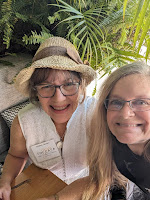



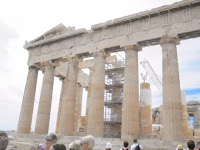







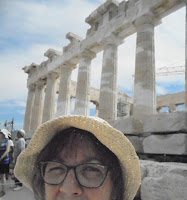





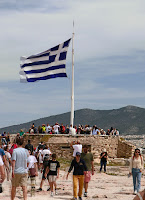

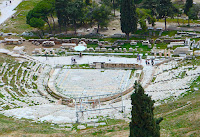



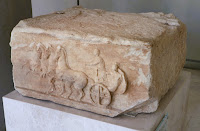




I liked your idea of seeing the museum first!!
ReplyDeleteI remember the museum with you. Wasn't there a little model on a table that you could look inside and see the statue of Athena all lit up and golden? I also recall, after studing art history, how excited I was to see the Elgin Marbles in London with Mama. I agree that it might have been more interesting for you to tour the museum first, but OMG, to BE there in PERSON! A place I've always dreamt of, but never figured I'd see, so I'm lovin' your narration of your trip!
ReplyDelete